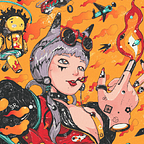Web3 Citizen
In the ever-evolving landscape of cryptocurrencies and blockchain technology, one challenge remains constant — the fragmentation of the crypto ecosystem. This fragmentation, fueled by intense competition among Layer 1 blockchains such as Ethereum, Solana, and Aptos, has led to a myriad of wallets and protocols, each with their own limitations and confined to specific blockchains. Furthermore, the countless Layer 2 networks on Ethereum amplify the intricacies of the problem. This fragmentation not only results in a cumbersome user experience but also poses a significant barrier to mainstream adoption.
The contemporary crypto user faces a multitude of challenges in navigating this fragmented landscape. Consider the convoluted process of interacting with an Ethereum dApp with USDC on Solana — this requires the user to access Wormhole, connect their Phantom wallet, select the token, connect their Metamask wallet, select the ERC20 target token, and bridge to ERC20 USDC. If the user lacks sufficient ETH for gas, they must then visit a DEX to buy and transfer more ETH.
Another example is buying NFTs on Ethereum, which necessitates payment in ETH. If a user wants to use ERC20 USDC or Solana USDC, they must first buy ETH and pay for the gas fees or follow a five-step, 20-minute process simply to buy an NFT. Not only is this caused by fragmentation, this process causes further fragmentation which creates a negative feedback loop.
While projects like Onto and Phantom wallet strive to develop multi-chain wallets, their solutions fall short. Though these wallets support numerous chains, the user experience remains disjointed, as users are still obligated to switch networks within the wallet.
A glimmer of hope exists in Ethereum’s ERC-4337 account abstraction, which permits transaction bundling and thus enhances the user experience by facilitating the use of USDC to purchase NFTs or to pay for gas on Ethereum. However, this improvement is exclusive to Ethereum, leaving the fragmentation issue unresolved in a multichain world.
As we venture further into a future dominated by multi-chain ecosystems, addressing this fragmentation becomes increasingly crucial. It is here that the Web3 Citizen Design Framework emerges — a concept that seeks to create a seamless, interconnected experience for users navigating multiple blockchains.
In this ideal world, users would only possess a single wallet for all of their Web3 activities, thereby becoming “Web3 Citizens.” Upon creating a username, wallet addresses for all major chains would be generated automatically, and the lesser known ones will be made as needed.
Like-assets will be bundled, for example, USDC in ETH, Solana, and BNB will be bundled under “USDC”. Users will be able to purchase an NFT on Ethereum (in ETH) and pay gas using ERC-20 USDC (or other non-native tokens like SOL Token), with the system efficiently determining the most gas-efficient path for asset transfer to ETH and initiating all of the transactions in one click.
Web3 Citizens could establish preferences for specific tokens or networks, and the system would autonomously manage incoming and outgoing transfers, utilizing the most gas-efficient routes. For example, you can put a preference to always accept USDC in a form of ERC-20, so when a friend pays in SOL, it will automatically be converted to ERC-20 USDC. If you don’t put preference, the most gas efficient incoming USDC transfers will be from the respective tokens/networks. This architecture would render network-switching obsolete, allowing users to connect their wallets and engage with dApps across a diverse range of chains seamlessly.
Omnichain projects like LayerZero hold the key to realizing the ambitious dream of the Web3 Citizen Design Framework. However, achieving this vision necessitates significant advancements in infrastructure development and application building. To conquer the challenges of fragmentation and forge a more accessible, user-centric crypto landscape, the blockchain community must unite, fostering collaboration and innovation in pursuit of a shared goal.
